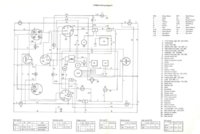ahh sorry larry I was referring to a slightly later schematic. Your bike has a different wiring layout than I thought.
Let me have a minute or two to digest the schematic ok

Right . your Starter relay (SR) is effectively a heavy duty electrical switch, what we would normally call a 'Solenoid' on a car.
it contains a switch and an activating coil
There is a constant direct 12v+ live feed to the SR (Red wire) Its live even with the key switch turned off.
The other red wire on the SR is switched live and goes to the starter motor . When you press the starter button an electrical current passes through the relay coil which energises the coil thus closing the integral switch which connects 12v+ to the starter motor.
Blimey thats hard to describe.
What you need to check is that you have good clean connections on your battery and on the starter relay connector and the starter motor particularly the ground for the starter motor.
First try connecting a battery jump lead from the battery - negative (black ground) terminal to the ground terminal on the starter motor. This will bypass the existing ground connection . See if there is any improvement in the starter motor operation.
To bypass the starter relay and the starter switch and test the starter motor ,all you need to do is to connect one end of a heavy duty wire to your + positive terminal of your battery and the other end briefly touch the red wire terminal on your starter motor which should cause your starter motor to turn over .
Make sure you are in neutral obviously and the main switch is off unless you want to try start the engine.
If that works every time then the problem likely lies in the starter switch, safety relay, stop switch, solenoid and all the associated wiring.









 well I guess you'd only do it the once
well I guess you'd only do it the once 